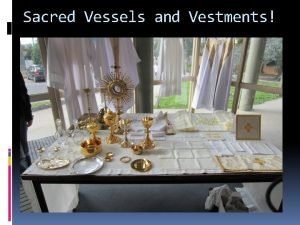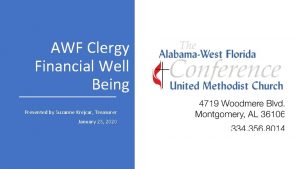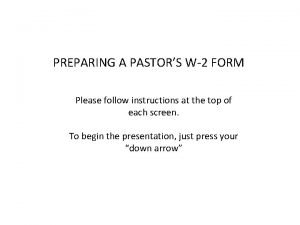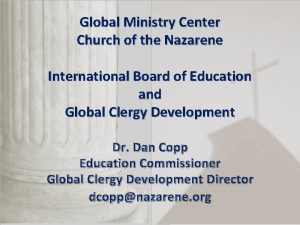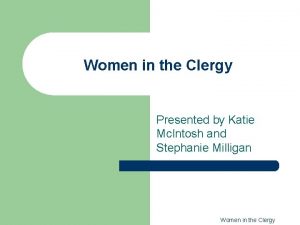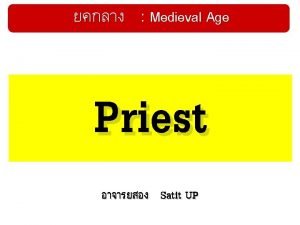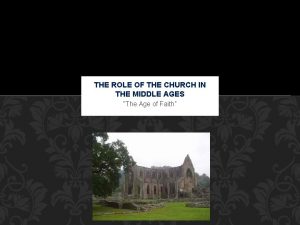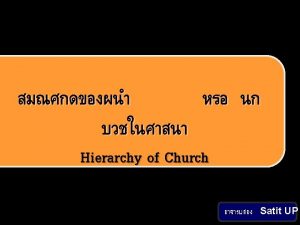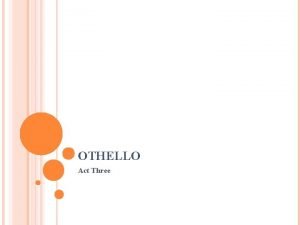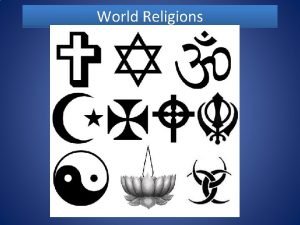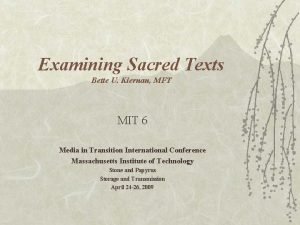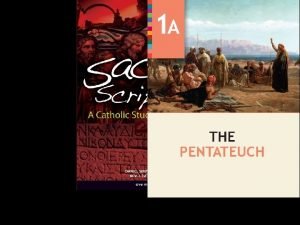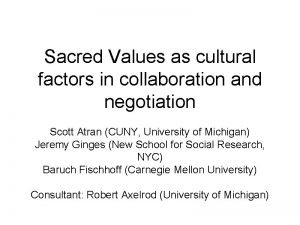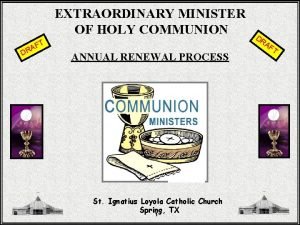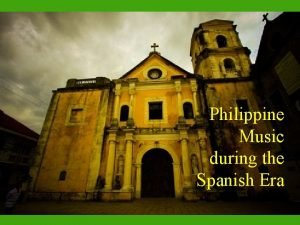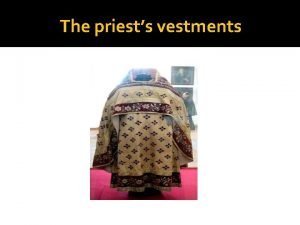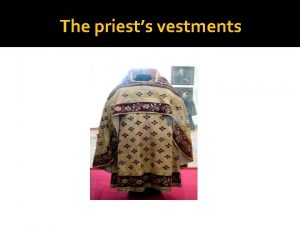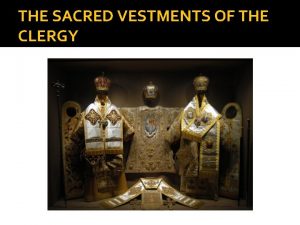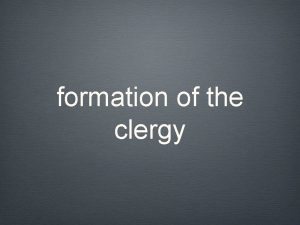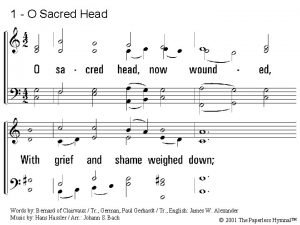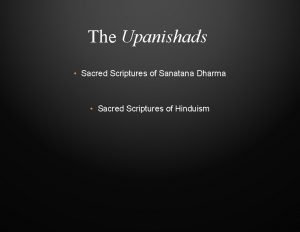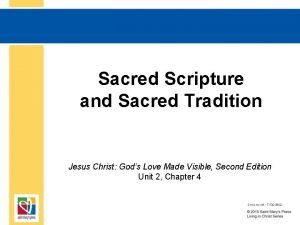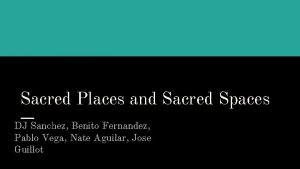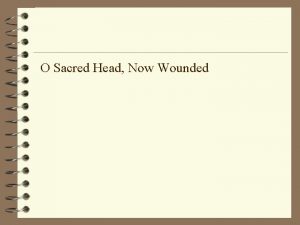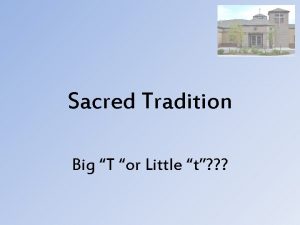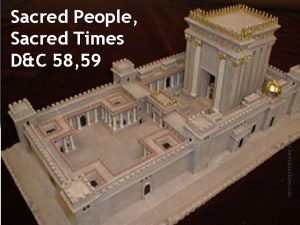THE SACRED VESTMENTS OF THE CLERGY THE THREE






























- Slides: 30

THE SACRED VESTMENTS OF THE CLERGY

THE THREE ORDERS OF PRIESTHOOD � In ancient times there were three classes who took part in public worship, in the Divine Liturgy and other services of the Church. � They were the clergy, the faithful and the catechumens

Divine liturgy today � Who takes part today in the Divine Liturgy and in other services of our Church? � The answer is, the clergy and the Christian laymen

Divine Liturgy - participants � We must remember, also, that neither the Divine Liturgy nor other church services can be celebrated if both the celebrant clergy and the Christian laymen do not participate � In fact, the celebrant clergymen celebrate the Divine Liturgy for the faithful and lead them in common worship at all church services

THE CELEBRANT CLERGY � The celebrant clergy are those persons who have received the grace of the Holy Spirit through the sacrament of Priesthood or Ordination � There are three orders of the priesthood: the Bishops, the Priests, and the Deacons

ORIGIN OF SACRAMENT OF PRIESTHOOD The Sacrament of Priesthood derives its origin from Christ, the great High Priest, Who was “holy, blameless, unstained, separated from sinners, exalted above the heavens… a minister in the sanctuary which is set up not by man but by the Lord” (Hebrews 7: 26, 8: 2) � Christ as the heavenly High Priest offered Himself as a sacrifice on the Cross “for all” and conferred His priesthood upon His Apostles (John 20: 21 -23, Matthew 28: 19 -20 ; Acts 2: 33) �

APOSTOLIC SUCCESSION From the Apostles the office of Priesthood passed on in an unbroken chain to the first clergymen whom they ordained, and through them to their successors. � This is called Apostolic succession and it is fundamental in our Church because only through it the clergymen can receive the authority to become real representatives of Christ and of Apostles in the Church �

THE ROLE OF THE CLERGY TODAY � As successors of the Apostles and representatives of Jesus Christ in His Church, clergymen continue the work of Jesus. � They teach the word of God; offer the Holy Eucharist and administer the other sacraments; � They govern the Church and take care of the spiritual needs of the members of their congregations

THREE ORDERS OF PRIESTHOODTHE BISHOP The first and highest order or degree of Priesthood belongs to the Bishop � The Bishop is the head of all parishes of a certain area called a diocese. He ordains priests and deacons, consecrates churches, and performs all the sacraments and church services � Bishops bless the Christians by using both hands or lighted candles called the Trikiron and Dikiron �

TITLES GIVEN TO BISHOPS � All bishops are equal among themselves as holding the same degree of priesthood � But there are grades in their titles, depending on their administrative power

METROPOLITAN Metropolitan, the bishop of a great or capital city otherwise called ‘metropolis’

ARCHBISHOP � Archbishop, the chief or first among the bishops of a large area

PATRIARCH � Patriarch, the chief over the bishops � This title was given to the bishops of ancient great cities of the Roman Empire from where the Christian faith spread over the globe � Those ancient cities are: Rome, Constantinople, Alexandria, Antioch and Jerusalem

SECOND ORDER OF PRIESTHOODTHE PRIEST The second order of Priesthood is occupied by the Priest � The Priest is in charge of a community or parish church which he spiritually governs and serves � He administers all the sacraments with the exception of the ceremony connected with the consecration of a church � He leads the people in prayer at public worship and blesses them in the name of the Lord �

TITLES BESTOWED ON THE PRIEST Titles bestowed on the priest for his distinguished services, long devoted service to the Church, the importance of the parish he serves are: � Arch-priest or Protopresbyter, i. e. the ‘first’ or ‘senior’ priest � Archimandrite (the head of the fold or of the monastery). This title is given only to unmarried clergymen and is the highest among all other titles. Only priests with this title are entitled to become bishops � Priests with titles such as the above have precedence over other priests of lower ranks when they perform services together �

THIRD ORDER OF PRIESTHOOD � � � The Deacon holds the third order of the Priesthood Deacon means ‘assistant’, ‘ministrant’ He assists the bishop or the priest in the performance of the sacraments and church services, but has not the right to perform them himself At public church services, he recites the litanies, the Gospel readings and other prayers and assists the celebrant bishop or priest in the sanctuary The senior deacons or those attached to the Archbishop or to cathedrals are called archdeacons or proto-deacons

THE ORIGIN OF THE SACRED VESTMENTS – early years In the very beginnings of the Church, clergymen wore the same kind of garments when officiating in public church services, as those worn by other people of that time � But even there was a feeling that the garments of the celebrant clergy should be distinguished in some way from those of the common people � This feeling of reverence demanded that the garments of the celebrant should be festive, preferably white in color –a symbol of holiness and purity and that they be decorated with crosses to distinguish them from ordinary garments �

THE ORIGINS OF THE SACRED VESTMENTS In the course of time, the fashions of the garments of peoples changed, but the garments of the celebrants remained unaltered and took on a symbolic meaning � They distinguished the officiating clergymen from the laymen and at the same time reminded them all that the celebrants “are not of the world” (John 17: 16) but participants of Christ’s glory clothed in the robes and the grace of the Holy Spirit �

� This is the reason that the special garments of the officiating clergymen are called “sacred or liturgical vestments” � The symbolic meaning of each garment is disclosed in the Bible verses which are recited by the celebrants as they put on each garment

ANCIENT GARMENTS � The liturgical vestments of the Christian Church developed from articles of dress worn at that time, the basic forms being inspired by classical Greek garments

The Chiton (Tunica) The basic garment (undergarment) which draped the body vertically

The Himation (Pallium) An elongated rectangular piece of cloth of varying length and width, wrapped around the body horizontally

The Chlamys (cloak, or toga) An outer garment in the form of a rectangular or semicircular mantle whose ends were brought together and fastened partially up the front

Liturgical vestments � These three basic garments with some alterations were of universal use during the Apostolic times and the first centuries of Christianity in the Greco. Roman world � They became the basis of the development of the liturgical or sacred vestments used in the church

Liturgical vestments � The chiton developed into the sticharion � The himation into the orarion, epitrachelion and omophorion � The chlamys into the phelonion and sakkos

Liturgival Vestments Each of the three degrees of clergy has its own special vestments � Although some are the same style for all three degrees, each higher degree has additional styles not possessed by the degree below it � In general, some of the Bishop’s vestments are different from those of the priest and the deacon, and some of the priest’s vestments vary from those of the deacon �

Liturgical Vestments � Before the officiating clergy put on their vestments, they bless and kiss each one as they recite a special passage from the Bible relative to the symbolism of the vestment

Reading Comprehension � Answer the following questions: Who participated in the services of the church in ancient times and � who does nowadays? Whose presence is absolutely necessary in the celebration of the Divine Liturgy and other church services? Who are the celebrant clergy? What is the apostolic succession? What are three orders of priesthood? What are the duties of a Bishop? Which sacrament cannot be performed by a priest? Which priests can become bishops? What is the role of the deacon during the public church services? Why are the clergy garments called ‘sacred or liturgical vestments’

Vocabulary exercise � Match the words with their Greek explantation: 1. 2. 3. 4. 5. 6. 7. 8. 9. 10. 11. 12. 13. 14. 15. common ___ grace ___ ordination___ derive ___ exalted ___ chain ___ succession___ spiritual __ grade ___ bestow ___ fold ___ precedence___ recite ___ right ___ senior ___ a. ποίμνιο b. αλυσίδα c. δικαίωμα d. πρεσβύτερος e. κοινός f. διαδοχή g. χάρη h. απαγγέλω i. χειροτονία j. πνευματικός k. προέρχομαι l. εξυψωμένος m. βαθμίδα n. απονέμω o. προβάδισμα � � � � 1. e 2. g 3. i 4. k 5. l 6. b 7. f 8. j 9. m 10. n 11. a 12. o 13. h 14. c 15. d

Cloze test � � � Fill in the gaps with one suitable word: 1. ___ the very beginning of the Church, clergymen wore the same 2. _____ of garments when officiating 3. ____ public church services, as those worn 4. ______ other people of that time. But even then 5. ____ was a feeling that the garments of the celebrant clergy should 6. _______ distinguished in some way from those of 7. _______ common people. 8. _____ feeling of reverence demanded that the garments of the celebrants 9. _____ be festive, preferably white in 10. ______ � - a symbol of holiness 11. ____ purity – and that they be decorated with crosses to distinguish 12. _____ from ordinary garments. � � � 1. at 2. kind 3. in 4. by 5. there 6. be 7. the 8. this 9. should 10. colour 11. and 12. them
 Vestments and vessels of the catholic church
Vestments and vessels of the catholic church Vestments and symbols of bishop
Vestments and symbols of bishop Clergy financial
Clergy financial Example of form w-2 for clergy
Example of form w-2 for clergy Church of the nazarene global ministry center
Church of the nazarene global ministry center Clergy definition
Clergy definition Roman catholic church hierarchy pyramid
Roman catholic church hierarchy pyramid Social structures
Social structures Nobles and clergy
Nobles and clergy What are the ranks in the catholic church
What are the ranks in the catholic church Church vessels and vestments
Church vessels and vestments Othello act three summary
Othello act three summary In three minutes write three things you did yesterday
In three minutes write three things you did yesterday The three colonial sections-one society or three
The three colonial sections-one society or three The purpose of traffic signs are
The purpose of traffic signs are Three hobbits and three orcs
Three hobbits and three orcs What is three address code
What is three address code Generator operator destroyer
Generator operator destroyer Taoism sacred scriptures
Taoism sacred scriptures Bette kiernan
Bette kiernan Sacred scripture a catholic study of god's word
Sacred scripture a catholic study of god's word Sacred values
Sacred values The sacred vessels
The sacred vessels Sacred and profane consumption
Sacred and profane consumption Sacred heart enthronement ceremony
Sacred heart enthronement ceremony Yawm al akhirah
Yawm al akhirah Primary author of the sacred scripture
Primary author of the sacred scripture The sacred rac meaning
The sacred rac meaning Sacred heart church sauk rapids
Sacred heart church sauk rapids Sacred music in the middle ages
Sacred music in the middle ages Gloria from pequena misa solemne
Gloria from pequena misa solemne
